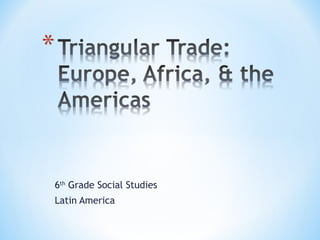
Slave trade triangular trade
- 1. 6th Grade Social Studies Latin America
- 2. *Slavery has existed since ancient times. *Egyptians, Greeks, Romans, Persians, Indians, and the Aztec captured enemies from battles and kept them as slaves. *Enslaved Aztec could buy or regain their freedom in time. *Africa traded people within the continent. *Men captured in battles between warring African tribes were taken as slaves rather than being killed. *The enslaved could either earn their freedom or a family member could buy it.
- 3. *Slave trade in the 1500s was different. *With the arrival of the Europeans, the demand for slaves in the Americas increased significantly. *While Pizarro was taking control of the Inca on the West Coast, Portugal claimed, what is today, Brazil. *Spanish and Portuguese settlers moved into the newly conquered lands. *They planned to mine gold, silver, and create sugarcane plantations.
- 4. *Millions died from disease brought by Europeans. *More died from the violence of war. *Natives were forced to farm or mine in harsh conditions- many died. *Many of the indigenous people retreated into the mountains or jungles. *Africans were preferred as laborers because they were more immune to European diseases. *African planters, if they ran away, did not blend into local society.
- 5. *The Portuguese population was too small to provide a large number of colonists. *The sugar plantations required a large labor force. *Slaves filled this demand. (both African Europeans and Africans & Native peoples) Meet to Trade
- 6. *Africans were brought by ship. *Most died on the trip either due to starvation or disease. *Once Africans arrived in the New World, they were forced to work on large plantations or in mines. *Children born to a slave were also considered slaves for their lifetime without a hope for freedom *Africans had to deal with… *Long working hours *Poor housing *Poor nutrition
- 7. *After crossing the Atlantic, most African slaves went to plantations in the tropical or subtropical regions of the western hemisphere. *The first was established by the Spanish on Hispaniola in 1516. *Originally the predominant crop was sugar. In addition to sugar, plantations produced crops like tobacco, indigo, and cotton. *1530s--Portuguese began organizing plantations in Brazil, and Brazil became the world’s leading supplier of sugar.
- 8. *Growing sugarcane in the tropics required a HUGE work source. *Sugarcane was used to make sugar, molasses, and rum. *Portuguese crop growers extended the use of slave labor to South America. *Because of this, Brazil would eventually become the wealthiest of the sugar-producing lands in the western hemisphere.
- 9. • One of the reasons the trade lasted for so long was because it was incredibly profitable. The British appeared to have an insatiable appetite for luxury goods from the Caribbean, especially sugar and this demand fuelled supply. • Before the twentieth century, sugar came in cones from which chunks would be nipped off and used to sweeten the bitter taste of coffee, chocolate and tea. What people consumed in one part of the world altered forever the lives of those from other parts of the world.
- 10. *In 1518, the first shipment of slaves went directly from West Africa to the Caribbean where the slaves worked on sugar plantations. *By the 1520s, the Spanish had introduced slaves to Mexico, Peru, and Central America where they worked as farmers and miners. *By the early 17th century, the British had introduced slaves to North America. *The plantation economies prospered because of slave labor. *Brazil imported more slaves than any other country in the world.
- 11. Triangular Trade Route
- 12. *The triangular trade demonstrates how people were reduced to commodities to be sold. *Goods such as metal, cloth, beads and guns went from Europe to Africa, enslaved Africans went to America and the Caribbean, and raw products such as sugar, tobacco and cotton came back to Europe. *Ships full of gold, silver, and sugarcane made regular trips to Spain and Portugal!
- 13. *The original capture of slaves was almost always violent. *As European demand grew, African chieftains organized raiding parties to seize individuals from neighboring societies. *Others launched wars specifically for the purpose of capturing slaves.
- 14. “Africans became enslaved mainly through four ways: first, criminals sold by the chiefs as punishment; secondly, free Africans obtained from raids by African and a few European gangs; thirdly, domestic slaves resold, and fourthly; prisoners of war." (Adu Boahen (University of Ghana).
- 15. *As the major European powers of Portugal, Britain, France, and the Netherlands looked for ways to exploit the fertile lands of the New World, they looked to Africa for a steady supply of labor. *African slaves had become vital to the cultivation of sugar, tobacco, cotton, and rice plantations. *European demand for sugar began to increase= plantations throughout Brazil and the Caribbean. *Many plantations produced additional crops such as indigo, rice, tobacco, and coffee.
- 16. *All were designed to export commercial crops for profit. *Relied almost exclusively on large amounts of slave labor supervised by small numbers of European or Euro- Brazilian sugar mill in American the 1830s managers.
- 17. *Cultural Diffusion: *The slave trade spread ideas & goods between cultures. *Europeans brought new weapons to Africa. *Africans brought part of their culture (music, traditions, food, language, etc.) to the Americas.